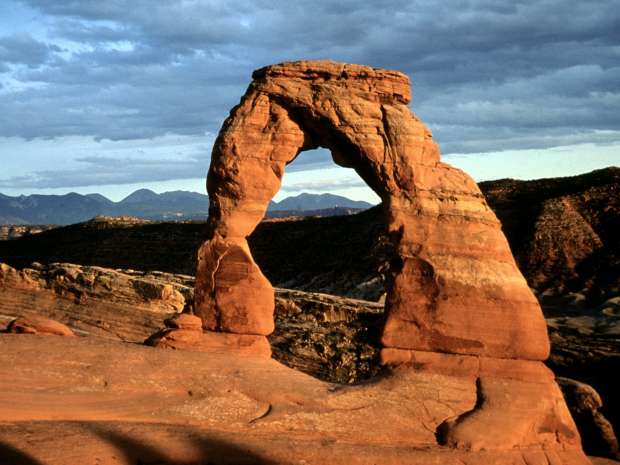One of the world’s greatest wonders, and the focus of Paiute and Navajo myth, a fabulous span of rosy sandstone curves over the rocky terrain of southern Utah like a rainbow turned to stone. The Paiute and Navajo people of southern Utah told tales of a legendary ‘rainbow of stone’, but the exact location of this great stone arch that reputedly mimicked the shape and colour of a rainbow was known only to a few of their number. Intrigued by rumours of such a stunning spectacle not far from Navajo Mountain, in 1909 a three-man party set out on horseback through rocky wastelands and winding canyons in the hope of finding this remarkable phenomenon. Guided by two Native Americans, they trekked through some of the most inhospitable country in the United States before finally reaching the great rainbow arch.
The horsemen were overawed by the sight that greeted them. Not only did the arch duplicate a rainbow in form but also in colour. Under a clear, bright sky the naturally pink stone appeared dark lavender; in the late afternoon sun it was splashed with streaks of russet red and brown.
The largest and most perfect natural rock formation of its kind, the graceful 309ft (94m) long sandstone bridge spans a canyon 278ft (85m) wide, almost the length of four tennis courts placed end to end. Its height of 290ft (88m) from the base to the top of the arch exceeds that of Nelson’s Column in London by 105ft (32m); the stone is 42ft (13m) thick and 33ft (10m) across, wide enough to accommodate two lanes of traffic. Its sheer size and magnificence prompted US president Theodore Roosevelt to declare it the greatest natural wonder in the world.
Jutting out from the cliff, of which it was once a solid buttress, the huge arch vaults over the modest trickle of Bridge Creek. Over many thousands of years the base of the stone buttress has been worn away by the creek’s seasonal torrents and abrasive silt, leaving the airy arch of the bridge suspended above it. The smooth lines of the stone sculpture were rounded and polished by the wind.
To the Navajo people, nonnezoshi ’rainbow of stone’, is a sacred place, and archaeological evidence found at the site indicates that it may once have been used as a place of worship. But access to the area, hidden away in a narrow canyon, is so difficult that when the first party of Europeans arrived there they understood why so few local Native Americans knew its exact whereabouts.
The bridge was declared a national monument in 1910, but only became generally accessible in 1963, following the completion of Glen Canyon Dam. The resulting lake, Lake Powell, raised the water level in the Colorado River replacing 13 miles (20km) of fiendishly difficult overland trails with easily navigated water passages. Visitors can now travel by boat to a viewing area for the bridge.

Utah contains thousands of similar sandstone arches, more than 2000 of which are found in arches National Park, 180 miles (300km) north of Rainbow Bridge. They range in size from a 1m (3ft) opening to mighty Landscape Arch, another record-breaker – its span of 290ft (89m) makes it the longest natural bridge in the world. As fragile as a collarbone – one stretch is just 6ft (1.8m) thick – its sandstone fin projects from the rugged outcrops of rock at an average height of some 30m (100ft) above the floor of the canyon.

Another of the park’s majestic structures is Delicate arch, known locally for its shape as Old maid’s Bloomers. Standing higher than a seven-storey building in proud isolation on the rim of a desolate rock bowl, it neatly frames the La Sal Mountains beyond.
Although water is scarce in the Utah Desert, it is, paradoxically, the action of water that is responsible for many of the stone formations found there. Some arches were created by streams eroding the rock at the base of a cliff, while leaving the top intact. Others resulted from water seeping into fractures in the rock and slowly eroding them until only narrow fins of rock remained. Holes that were made through the fins were gradually enlarged by weathering and rock falls to form natural arches.

Rainbow Bridge was formed by the action of the creek that still runs below it, Bridge Creek. Millions of years ago, a lone sandstone buttress jutted out from the side of the canyon. The water of Bridge Creek, carrying a heavy load of silt and other debris, would have continually crashed into the buttress in its headlong career downstream. During many centuries, this action along with the weathering effects of wind and sand, gradually ate into the base of the buttress, wearing a small opening in the soft sandstone.
Constant bombardment with silt, and extreme shifts of temperature over thousands of years, would have caused the rock to expand and contract violently, slowly widening the hole in the sandstone buttress until it was eroded into the shape of a bow. At the same time, the water of the creek carved out a small canyon below what had become a huge arch, accentuating its height, while the wind sculpted and polished the stone of Rainbow Bridge into its present beautiful symmetry.



































